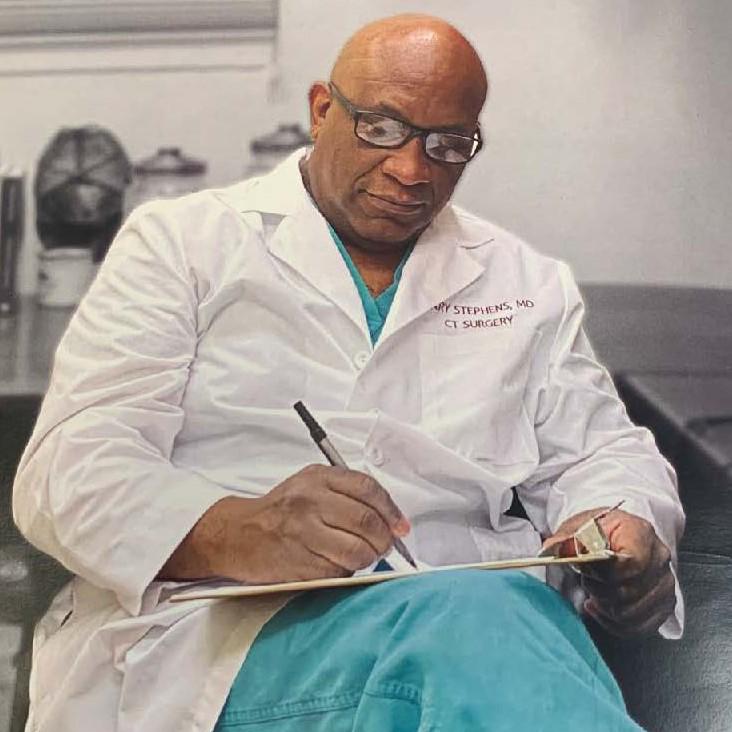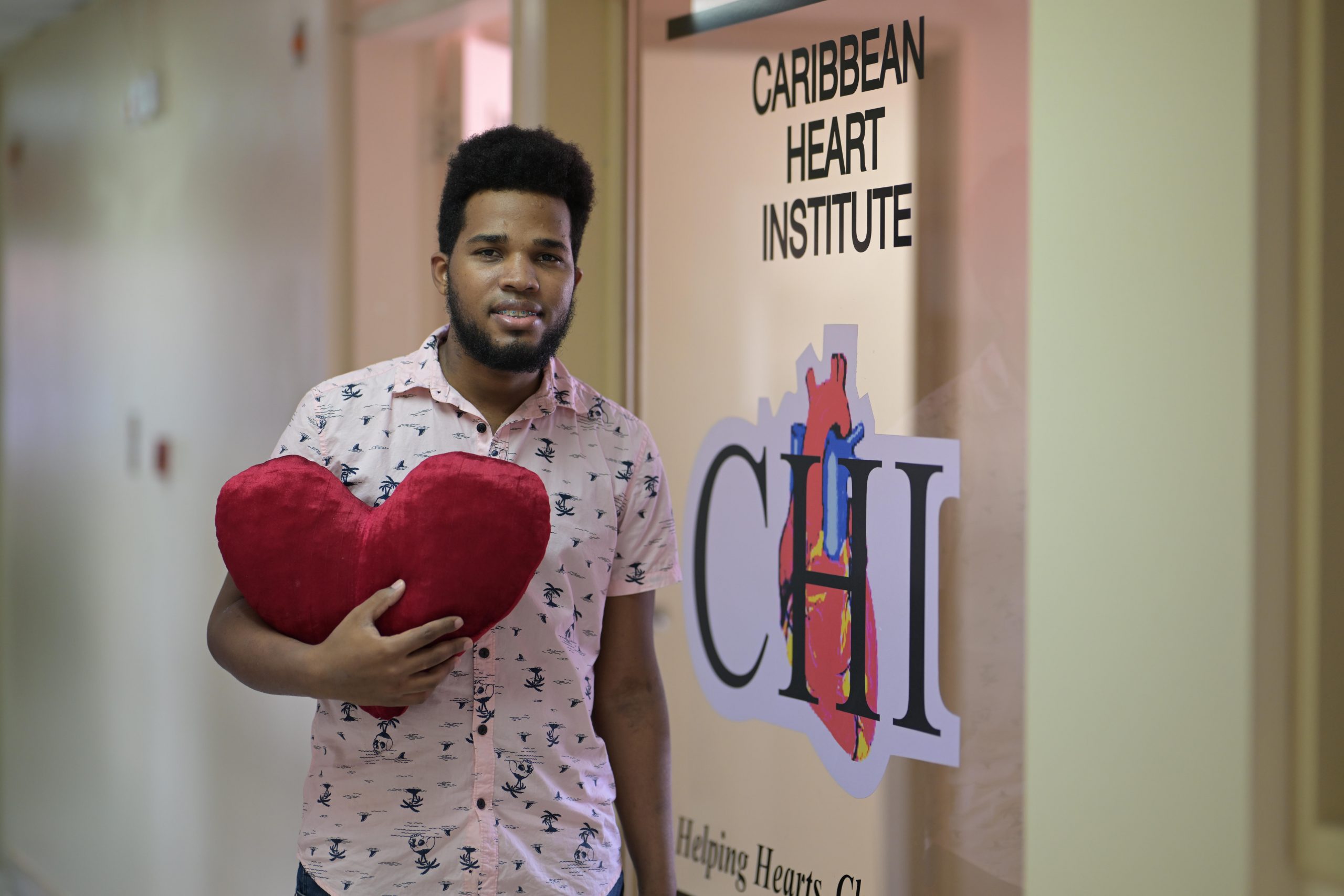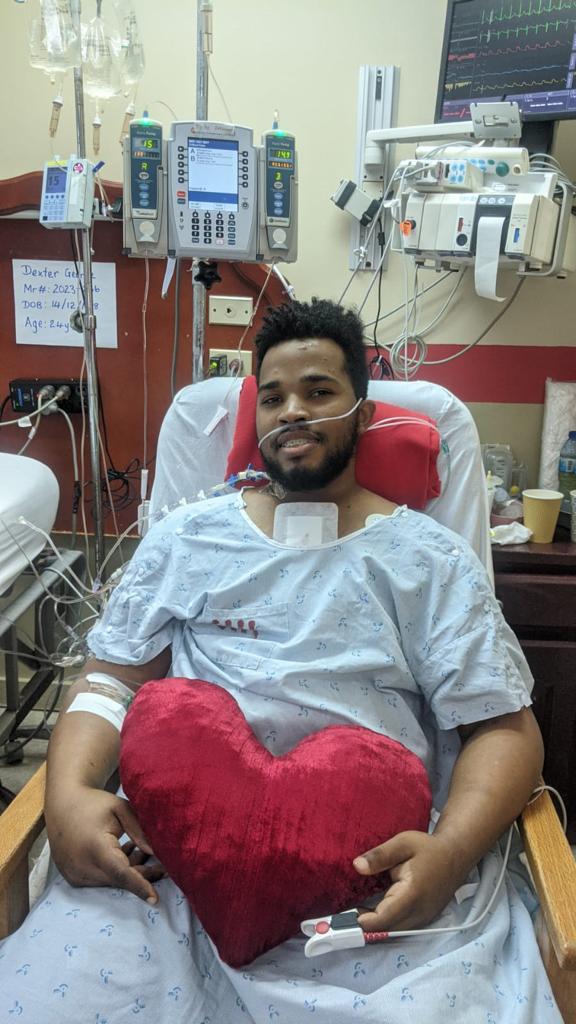On the verge of death, 24-year-old Dexter George now has a new lease on life after CHI surgeons used cow tissue to repair his heart in what is believed to be the first time this procedure has been utilised here.
The revolutionary surgery was done under the leadership of Chief Executive Officer (CEO) of the Caribbean Heart Institute (CHI) and Guyanese surgeon, Dr Gary Stephens and his team.
CHI provides cardiac care in an arrangement with the Georgetown Public Hospital.
A release today from CHI said that George’s ordeal began earlier this year when he was diagnosed with a severe cardiac condition. In the latter part of 2022, he had been involved in an almost fatal stabbing which caused him to be hospitalised. It was then that doctors discovered a small lesion in the right atrium of his heart. This was initially believed to be a blood clot.
Over nine months, the lesion grew to over 10 cm in size and partially blocked the Inferior and Superior vena cava, damaged 90% of the right atrium, and severely compromised the function of George’s heart. The release said that he found himself in a state of right-sided heart failure, breathing difficulties, an engorged liver, and the inability to leave his bed unassisted.
Initially, upon observing the advanced state of the tumour, the release said that the surgical team reluctantly concluded that there was little that could be done for Dexter. However the team made a bold proposition. The release said that they offered to perform a procedure that involved excision of the cardiac tumour, subtotal excision of the right atrium and reconstruction of the right atrium with bovine pericardium.
“The chances of survival were incredibly slim, less than one per cent, but both Dexter and his family bravely agreed to take the risk. With heavy hearts, they bid farewell to their loved one and prepared for an arduous surgical endeavor”, the release said.
The surgical team then removed 90% of George’s right atrium along with the tumour that had plagued his heart. To reconstruct the damaged right atrium, they used an unconventional technique, utilising tissue derived from the lining of a cow’s heart. The nature of the mass, whether a cancerous angiosarcoma or a clot assimilated into the heart’s wall, awaits confirmation from the pathology report.
Challenges

In an interview, Dr. Stephens said “The procedure challenged the conventional understanding of the heart’s resilience, illustrating that substantial portions of the heart can be removed with positive outcomes”.
He added, “This remarkable feat could pave the way for more aggressive approaches in similar cases, pushing beyond traditional boundaries”.
The release said that the surgical team encountered several challenges during the procedure.
Dr Stephens said that these were accessing the heart: George’s previous chest surgery posed a significant risk of damaging the heart during the chest opening. To mitigate this, a specialised saw was used, reducing its power when encountering soft tissue and minimising the risk of harm.
Navigating vessel obstruction: Freeing the heart and major vessels for cardiopulmonary bypass proved challenging due to the location of the tumour. However, the team employed an alternative method, overcoming the obstacle in three hours. Blood loss amounted to three units.
Clamping the inferior vena cava: Ensuring the prevention of air entering the heart-lung machine required clamping the inferior vena cava. The release said that this presented a significant challenge, but ultimately, the team achieved success.
Reconstructing the right atrium: After removing the tumour and a substantial portion of the right atrium, the team reconstructed it using tissue from a cow’s heart. Surgical seam, bio-glue, and starch were used to facilitate proper functionality and prevent blood leakage.
The release said that Dexter’s condition showed remarkable improvement post-surgery. He regained his ability to move independently, experienced better breathing, and saw a significant recovery of his heart function. According to Dexter, “Physically I get a little pain but I am happy, I know I haven’t fully recovered as yet but I know I will get there soon, I am just trying to push myself with my exercises so I can be okay.”
Dr Stephens predicts that George’s recovery process will continue to be positive “From the physical standpoint we do not anticipate any issues, a lot depends on what the pathology report states; this will ultimately dictate the kind of life he will have”.
Stabbed four times

In the latter part of 2022, the release said that George was hospitalised after being stabbed four times on the left side of his chest. The attack could have been fatal if not for prompt medical intervention. Following an initial surgical procedure, Dexter received life-altering news when he was told of the tumour.
Before his first incident, the release said that George was like any other young adult his age. He worked as a welder during the week and enjoyed socialising with friends on the weekends, as he explained. However, in June, Dexter fell ill with a sudden fever and cold. Upon returning to the hospital, he was told that he had a mass on his heart. Soon after, he began to notice significant changes in his daily activities, such as experiencing shortness of breath. These symptoms worsened to the point where he became bedridden and unable to perform even the simplest tasks.
Dexter recounted, “My initial reaction was like ‘Okay this is happening’ I know I have it, I have to keep positive.” He said his family were very supportive and remained by his side through the entire ordeal, “And that is what kept me, they supported me a lot and that is what made me say ‘I have to take this risk’.”
The release said that the power of prayer played a pivotal role in sustaining Dexter and his family as they navigated the proverbial ‘tough waters’ in pursuing this risky procedure. “I was here in the hospital, I couldn’t move really and when I did move I was getting shortness of breath. I was like ‘Is best I take the risk’ If I didn’t get this surgery I wouldn’t have lasted too long. I was praying to God and thanked him for coming out of this successfully and now we are here.”
When asked about how he feels to be part of medical history in Guyana, he said, “I feel happy being part of the history and would like to encourage persons facing similar medical issues to be positive and take risks because the doctors do a very good job and it’s a nice opportunity to have life.”
CHI is located within the Georgetown Public Hospital.






